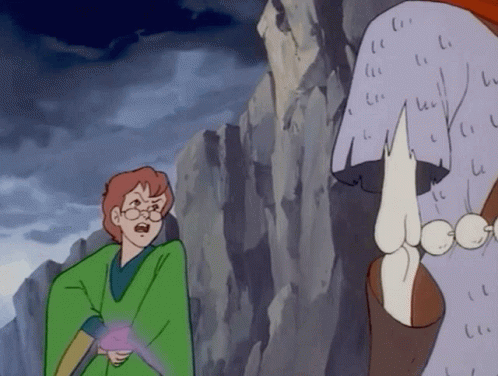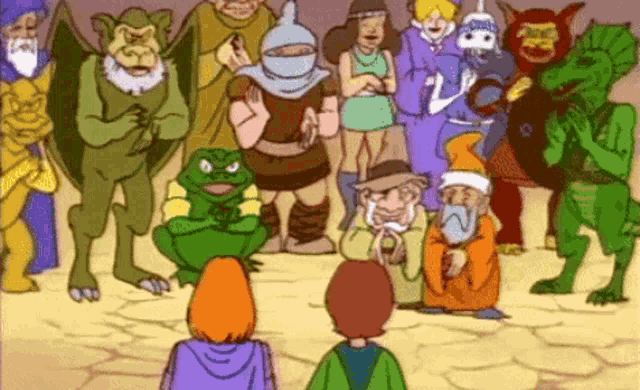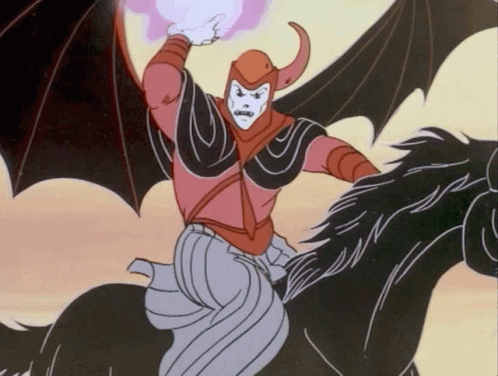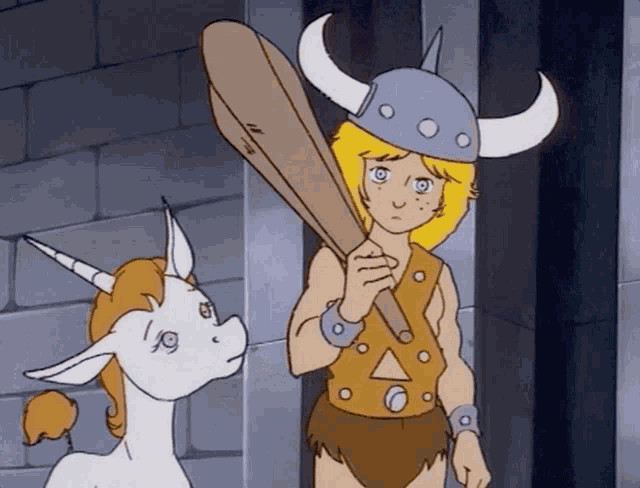Dungeons & Dragons Cartoon Adventure Guidelines
Guidance and house rules for 80s animated mayhem!
The D&D Cartoon Adventure series is part of a pledge drive to support game content on this newsletter. Click here to help with a one-time $20 pledge!
The Dungeons & Dragons animated series hit Saturday morning television in 1983 and was very much a product of its time. Changes to broadcasting rules allowed programming that was essentially a commercial for a line of toys–creating stories and characters beloved by Gen-X kids while being some of the most brazen examples of marketing aimed directly at children. But the D&D cartoon sits in a strange place, as the series didn’t tie directly to the game nor was there more than a little crossover with the LJN toys. It did not take place in any of the previously defined settings for the games or fiction.
While the cartoon’s long-term success might have benefited from a stronger marketing hook, it owned its own corner of the D&D multiverse and that allowed it to find its own voice as a fusion between the tropes of the World’s Greatest Roleplaying Game and children’s animation of the era. And like a slice of cheese on a piece of apple pie, these tropes don’t seem like they should go together but somehow the pairing works.
What follows are my suggestions for running D&D cartoon adventures that feel like episodes of the show. These are mostly narrative and descriptive changes paired with a few house rules. Then we’ll explore ways to modify the adventure “Uni and the Search for the Lost Horn” for it to use the younger heroes and fit within the timeline of the show.
It’s worth noting that while I had a lot of fun using custom miniatures for my convention events, D&D cartoon adventures are an especially good choice for Theater of the Mind sessions. Exact distances and strict rules interpretations are way less important than capturing the spirit and fun from the show.
One Session, One Episode
Keep it short and sweet! The original cartoon was a half hour that included commercial breaks for us to run to the bathroom or refill our cereal bowl. For gaming purposes that means one adventure should be completed in a single 3-4 hour session. And while there might be some NPCs or monsters that return in future installments, each episode should stand on its own and have a definite conclusion.
Optional: Theatrical Goofiness
If you’re running cartoon-themed D&D sessions you ought to go all the way. When I run these events at conventions I always start by playing the opening credits sequence on a tablet to get the whole group into the spirit of things.
That’s probably enough but if you’re like me you’ll pick a couple of cheesy 80s commercials to play after bathroom breaks, and you’ll listen to the closing credits music as everyone packs up when it’s all over. The outro tune was so lovely that composer Johnny Douglas wrote a new arrangement for a collection of favorites from his career. Sometimes those extra little flourishes help keep players in the right headspace for a few hours of cartoon adventuring.
Scenes & Transitions
Most RPG campaigns tend toward one long, chronological narrative–especially inside a single adventure–like a long fantasy novel that follows the heroes exclusively. But now you’re free to think like a cartoon screenwriter! While you should always respect player agency and let their characters try things, you can otherwise begin and end a scene at any point and just summarize the situation up to this point—or do a wrap up to transition into the next scene.
While it’s fine to have a D&D cartoon adventure begin with the heroes meeting up with Dungeon Master and receiving an enigmatic clue, you can begin the action in media res and explain to the players why the gang is running from a gang of ogres or battling a giant rhinoceros beetle. And just like a teleplay you should think about storytelling efficiency, and only begin at a scene just before an important plot point is introduced or a vital choice must be made. Once the important information has been revealed or the action resolved, only hang around long enough for an extra beat or to get a laugh before cutting to the next scene.
Optional: Non-POV Scenes
In a cartoon it’s the writer’s job to make sure the audience understands the story they are telling, and while the action usually follows our heroes, we’ll also get scenes featuring the villain revealing the evil plan or other characters explaining vital information. Often this means we, the audience, have information our main characters don’t–a technique that builds tension heading towards the climax.
These sorts of scenes work differently at the game table, as here the heroes and the “audience” are one and the same. Often you want the players to learn important plot points at the same time as their characters for honest reactions and the pure fun of it. But to keep the spirit of the cartoon you can cut away to short scenes outside the heroes’ point of view to reinforce information the players might already know (the goblin bandits are raiding the village the gang visited earlier). It can also offer the players the fun roleplaying opportunity of “playing dumb” after you shift to a scene in which the villains explain everything (Venger tells Shadow Demon to how the Cauldron of Lost Souls can summon an army of wraiths from the netherworld).
Just keep such scenes short and sweet, and if possible find ways for the players to participate such as reading a pre-prepared “script.” A DM who spends too long on a scene without any player characters might be accused of playing with themselves.
Change the Window Dressing As Needed
The rules are there to provide structure to action scenes with appropriate levels of challenge, so we can largely use them as-is. Just remember that we can and should adjust the fiction presented in the rules to fit our 80s animation sensibilities and the tropes of the Dungeons & Dragons cartoon in particular.
For example, the official description of the spell Magic Missile is “three glowing darts of magical force.” So when Presto’s player declares his spell (“Here I stand, here I shout – let my missiles seek them out!”) you completely ignore the Player’s Handbook and instead describe three tiny ballistic missiles flying out of Presto’s hat and exploding directly in front of the bad guys. Same dice, same damage, different description.
Remember the Target Audience
We’re recreating the feel of a cartoon made for kids ages 5 to 12, in an era where the broadcasting rules had strict moral requirements. This means relatively simple storylines with clear moral boundaries. There are no depictions of drugs, alcohol, or sexual situations. The bad guy’s goals are thwarted by the end of the story and the status quo is reset so kids who miss episodes or jump in the series late won’t be lost. And while the D&D cartoon didn’t end with a special “moral lesson” or educational segment like other cartoons of its era, each story offers a clear example that even kids can follow. This ties directly into …
Tone Down the Violence
Dungeons & Dragons is a violent game, and a typical session leaves a pile of monster (or even humanoid) corpses behind. But this is an 80s cartoon, where death or even serious injury does not occur on-screen. So how does that work?
Encourage and Reward Nonviolent Solutions
The D&D cartoon was filled with action and plenty of combat, but it was also a kids’ cartoon. While we can expect Bobby to go full Leeroy Jenkins in many situations, there are times when our heroes can avoid violence using wit or charm. They might distract an enemy with a tempting reward or scare them with a hoax or daring bluff. Monsters might respond to riddles, offer a bargain, or fall for a ridiculous trick. Like everything else, if it fits the spirit of a cartoon adventure you should assign a roll and give the player a fair chance to succeed. This is meant to be kind of silly, so lean into it and spin the scene to the delight of your inner child.
Of course, sometimes the players can’t think of anything, they roll badly, or just want some good ol’ mayhem. The D&D combat rules work just fine as long as you interpret them through the lens of 80s cartoon action.
Interpreting Hit Points & Damage
One of the fun things about hit points is they are completely abstract, letting us interpret them within the fiction of the game however we want. The core rules encourage us to think of losing hit points as direct injury, but a character or monster with a single hit point is just as effective as they were immediately after a long rest.
If a monster is reduced to 0 Hit Points they are immediately Out of the Action (see below). Be creative and take inspiration from the cartoon to describe the results. Attacks often cause pieces of scenery to fall and trap opponents, or they get scared by the heroes’ prowess and the bad guys scramble away in fear. They might give up or simply pass out (leaving them Unconscious). Encourage the players to help by framing their attacks in terms that would make it past the censors of the 1980s.
In the cartoon we see very few examples of injury. Instead, our heroes get startled and shaken by enemy attacks. They don’t bleed but they lose confidence as they are pressed to their limits. So think of hit points in cartoon adventures as a pool of luck and resolve, and once it runs out they are out of the scene.
House Rules
In Trouble. If a player character reaches 0 Hit Points and doesn’t “die” instantly (resulting in them being Out of the Action) they are not Unconscious but instead have the new In Trouble condition. This represents that their luck and resolve have completely run out. Being In Trouble has the following effects:
Helpless. You are Prone, your movement is 0, and you cannot take any action, Bonus Action, or Reaction.
Limited Communication. You cannot speak normally and can only cry out for help.
No Concentration. Your Concentration is broken.
Out of the Action. A player character who is Out of the Action has no Hit Points and cannot regain them in the current scene, and is out of the player’s control and ability for the other characters to aid them. The DM can decide the exact nature of how they are out of the action, which might involve them being trapped underneath rubble, fallen into a pit, or captured by enemies. Or the DM might declare the PC is Unconscious and cannot be revived until the next scene. At the beginning of the next scene they gain 1 Hit Point and might be allowed the benefit of a Short Rest depending on the nature of the scene.
Resolve Saving Throws. Whenever a player character starts their turn with 0 Hit Points, they must make a Resolve Saving Throw to determine whether they can hang in there or are out of the scene.
Three Successes/Failures. Roll 1d20. If the roll is 10 or higher, you succeed. Otherwise, you fail. A success or failure has no effect by itself. On your third success you gain 1 Hit Point and can act normally on your next turn. On your third failure, you are Out of the Action.
Rolling a 1 or 20. When you roll a 1 on the d20 for a Resolve Saving Throw, you suffer two failures. If you roll a 20 on the d20, you may spend one Hit Point Die and gain the equivalent number of Hit Points.
Damage at 0 Hit Points. If you take any damage while you have 0 Hit Points, you suffer a Resolve Saving Throw failure. If the damage is from a Critical Hit, you suffer two failures instead. If the damage equals or exceeds your Hit Point maximum, you are Out of the Action.
Encourage & Reward Creativity
We want our players to experience a fun and challenging adventure, but when recreating the magic of the cartoon it’s best to relax the strictest interpretations of the rules and encourage the players to think outside the box–something we should remember in all of our games but it’s especially true here.
Players will come up with a crazy idea for Hank’s energy bow or Presto’s player comes up with a hilarious rhyme when trying something that is definitely not on his spell list, and that’s great! The cartoon didn’t represent by-the-book D&D in the 80s and it certainly doesn’t match it now. If the players come up with a plausible idea, figure out an attack roll or ability/skill check that seems the closest and give it a decent chance to succeed. This is an area where the “Yes, And” spirit of improv comedy will allow your players to have a blast at your table as they try crazy stuff and have a chance at spectacular success or ridiculous failure.
Adapting “Uni and the Hunt for the Lost Horn”
The official D&D cartoon adventure by Wizards of the Coast is a lot of fun, but it’s written as a return to the realm by now adult heroes who are meant to reflect the modern D&D rules more than the tropes of the original show. If you’d like to run this adventure as a continuation of the animated series set in the Realm with the heroes still 80s youngsters and the action cartoon-appropriate, use the modified premade characters, guidelines listed above, and a few adventure-specific suggestions below.
For Timeline Nerds. The Dungeons & Dragons cartoon was a highly episodic show in which each installment can be safely watched in any order, so this isn’t important. But if a player asks you can tell them this is an episode set in an imagined fourth season of the animated series–sometime before the unaired finale episode, “Requiem.”
Adventure Hook
Desperately Seeking Uni. The heroes awaken at camp to find Uni the baby unicorn missing, lured away by a familiar enemy. Recovering their companion (and Bobby’s best friend!) is a top priority. You can roleplay the characters waking up in camp to find Uni missing, or start with the heroes in the midst of the search.
Bobby’s Extra Mad
Until Uni is rescued and fully restored at the conclusion of the adventure, Bobby deals one extra point of Rage damage.
Uni is a Baby Unicorn
Ignore the description of Uni provided in the text. She is still a baby unicorn and uses the statistics provided on Bobby the Barbarian’s character sheet except she cannot use the Radiant Horn, Healing Touch, or Misty Step actions. She can only communicate in incoherent bleats, though Fey creatures seem to understand her meaning.
Optional: Help From Dungeon Master
You can begin with the opening scene as described in the original text, or replace “Uni in Danger” with the following:
A familiar figure waits on the far side of a large oak tree, a short bald man in red robes, his usual amused expression replaced with concern. It’s Dungeon Master.
“The little unicorn is in danger, my young friends, and it’s not enough to rescue her. You must venture to the Inside to make her whole again, confronting an old adversary while a greater one watches.”
The heroes might ask questions or express frustration with Dungeon Master’s cryptic phrase, but there’s only one thing further he’ll offer: “Act quickly, or your chance to save her will go up in smoke!” He points farther down the forest trail toward trails of colorful smoke rising from distant treetops. When the heroes look back, Dungeon Master is gone.
Next Time: An original D&D cartoon adventure: “The Land of Forever.”
Thanks for reading! If you’d like to support the content on this site (and sure hope you will if you can afford it) with a one-time $20 pledge or a contribution to the Tip Jar I’d deeply appreciate it!
If it’s your first time here you can subscribe for free or with a paid membership:







Pity Ernie Gygax died about a month ago - he was part of the team that wrote the guidelines and approved the scripts for the actual show and would have loved to critique this I think
I love the Dungeons and Dragons cartoon. I used to watch it in the late 80s, early 90s, when I grew up in Rio de Janeiro. It was a hit among all the kids there. It probably helped me deal with some frustrations and choices, since each episode ended the way it did... So much nostalgia.